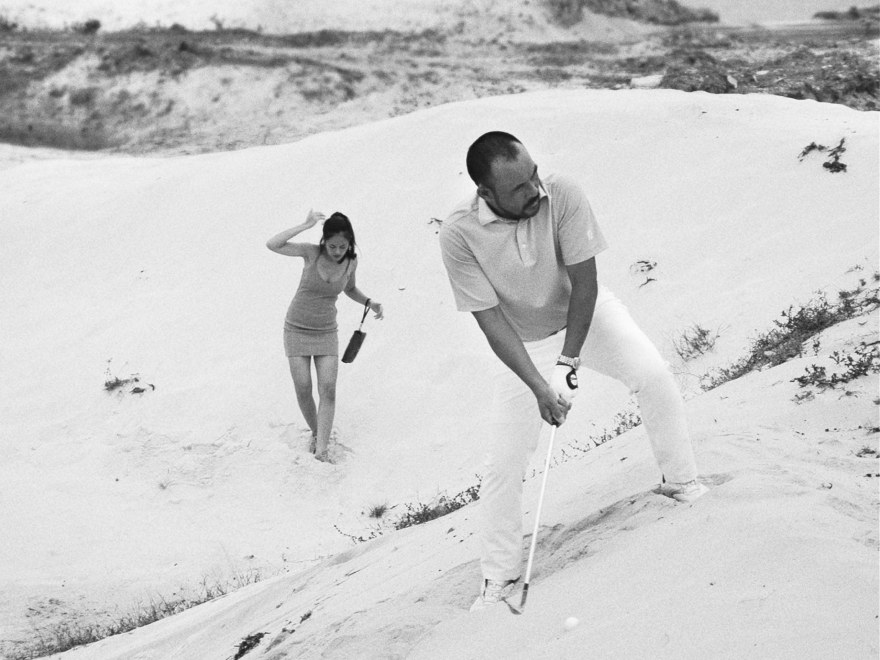Dinner with Blessed Land
Interview with Lan Pham Ngoc, director of Blessed Land
Why did you choose black and white?
Actually, if you watch closely, you will notice the film has a tinge of sepia instead of only black and white. The reason for this color palette and why we switched to a super zoom lens was production cost issues. This decision was made during the third day of filming when we learned that the permit for one of our shooting locations was denied, and production would need to halt for a month for scouting and other adjustments. Shooting in this color (which also minimalized staging and produced a classical style effect) helped us save in a lot of costs: using only the old Angenieux 25-250 T3.2 zoom lens instead of expensive prime lenses, getting rid of dolly and technical crew members; make-up artists and costume designers also became redundant, since makeup and costumes were now held to less stringent standards. Creatively, I believe that this classical cover provided the film with a sense of existing beyond time. And because time and memory are themes I want to emphasize in this film, I found myself fortunate that everything just kind of clicked together.
Why did you decide to set the scene in a cemetery? How did you get the inspiration for the landscape transformation? Was the building of the golf course only an excuse for stirring up trouble or has it also got a meaning?
It’s undeniable that Vietnam is changing very quickly today. This transformation is not only imposed on unknown or unnamed locations, but also on sites with symbolic and historical significance to the country. If you travel to Vietnam, then leave and come back six months later, there’s a chance that you won’t even recognize the places you stayed at or visited earlier. This occurrence is something you will definitely notice once you spend some time here. The cemetery setting has a very interesting history. This cemetery belongs to a seaside fishing village – Christian and very poor. During the “boat people” period in Vietnam, many left the village in hopes of reaching America. Some drowned, some succeeded. Those who succeeded began sending money back home to build such grand and extravagant tombstones. Saint Andrew is both the patron saint of fishermen and golf. A funny thought suddenly crossed my mind that even if capitalism lays claim to this seaside land and turns it into a golf course, ultimately nothing would change because both lands would still have the same patron saint. The issue would simply just be like switching a golf ball from your left pocket to your right pocket.
How much are you interested in mother-son relationships and do you have further projects on this theme?
Oh, I actually did not give a lot of thought to this specific relationship. Personally, my relationship with my mother has always been peaceful and cool, nothing galvanizing enough to convert into creative motivation. However, in my other films, my protagonists always seem to be searching and pining for something. What it is I still have no fitting answer for.
How did you work on sound effects?
I have a very special sensitivity for sounds. And I mean sounds, not music. I hardly ever listen to music because I feel like it seeks to hypnotize and distract from personal thoughts. Sound is different, when I hear a “good” sound, I feel elated. To me, giving yourself into sounds is easier than music, because sounds have the necessary openness for creative imagination. Along with my sound designer, we find and try to create background noise first. Next, come dialogue adjustments and sound effects. The sounds of the film rely on opposites, similar to the two storylines: nature and man, nature and construction, ground and heaven, light and dark…
Would you say that the short film format has given you any particular freedom?
Correct. The short film format is always free and beautiful. Sometimes it may even be too unrestrained. Perhaps the most beautiful aspect about this format is that it delivers the thrills and joys of filmmaking without the risks, costs, and commitment that come with feature filmmaking.
What are your reference works?
None, for this film.
Blessed Land is part of Lab Competition L4.








